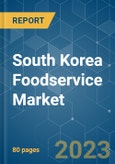The South Korean foodservice market is projected to register a CAGR of 4.63% over the next five years.
Over the long term, the increasing Western influence is expected to prompt South Korean consumers to opt for fusion foods and exotic blends of cuisine. Restaurants and cafes have quickly captured this trend and modified their offerings to suit consumers’ evolving palates. The restaurant sector in the country includes a wide variety of operators, ranging from American-style fast food chains to more traditional, family-owned, single-outlet restaurants. Tourism in South Korea has also increased since the pandemic. People have been traveling and visiting Korea for business trips, higher studies, and some just for tourism. According to Trade Economics data for 2022, South Korea's tourism revenue in February 2022 is USD 7,48,100 million.These factors are also driving the market, as tourists always try unique Korean dishes like kimbap, ramyeon, jajangmyeon, and many more.
Quick-service chain operators are well-represented in the channel. In the QSR channel, both domestic and international operators hold a significant market share. A large proportion of channel visitors indicated brand familiarity and habit as critical drivers for their choice of store, in addition to convenience-based factors. South Korea has one of the most vibrant coffee scenes in the world, with its capital, Seoul, boasting over 18,000 cafes. Thus, the cafes and bars segment is projected to witness significant growth during the forecast period.
This product will be delivered within 2 business days.
Over the long term, the increasing Western influence is expected to prompt South Korean consumers to opt for fusion foods and exotic blends of cuisine. Restaurants and cafes have quickly captured this trend and modified their offerings to suit consumers’ evolving palates. The restaurant sector in the country includes a wide variety of operators, ranging from American-style fast food chains to more traditional, family-owned, single-outlet restaurants. Tourism in South Korea has also increased since the pandemic. People have been traveling and visiting Korea for business trips, higher studies, and some just for tourism. According to Trade Economics data for 2022, South Korea's tourism revenue in February 2022 is USD 7,48,100 million.These factors are also driving the market, as tourists always try unique Korean dishes like kimbap, ramyeon, jajangmyeon, and many more.
Quick-service chain operators are well-represented in the channel. In the QSR channel, both domestic and international operators hold a significant market share. A large proportion of channel visitors indicated brand familiarity and habit as critical drivers for their choice of store, in addition to convenience-based factors. South Korea has one of the most vibrant coffee scenes in the world, with its capital, Seoul, boasting over 18,000 cafes. Thus, the cafes and bars segment is projected to witness significant growth during the forecast period.
South Korea Foodservice Market Trends
Growing Demand for Online Delivery Services of Meals
Convenience remains an important factor driving the eating habits of South Koreans with busy lifestyles. Hence, foodservice operators and other food manufacturers are developing more convenient and healthier food delivery options via online delivery. Moreover, the COVID-19 pandemic-induced restrictions accelerated the demand for online food delivery. Such evolving factors led to the emergence of several food delivery applications in the country as consumers registered burgeoning demand for online delivery of meals at their respective workplaces or homes. This trend created great opportunities for online food delivery applications to provide a differentiated order experience to consumers by adopting various strategies, such as offering discounts. The food delivery app market in South Korea is dominated by Woowa Brothers, followed by Delivery Hero. The food delivery apps are expanding their services as a part of their marketing strategy to penetrate the digital food market and capitalize on their position.Surge in Demand for Fast Food Among Consumers
The fast-food restaurant segment was recorded as one of the fastest-growing segments in the South Korean foodservice market. The increased demand in the fast-food restaurant segment is highly associated with convenience. As Koreans are working longer hours, they are increasingly valuing the convenience of fast food while also incorporating healthy eating habits. The school-going students and kids are also busy with school; therefore, fast food is the best option for them during meal times. The fast food outlets in South Korea and other quick foodservice restaurants that offer a diverse range of menus at lower prices registered faster sales growth than other consumer foodservice outlets. The South Korean foodservice market is growing due to fast food operators actively launching set-meal menus at competitive prices and constantly offering diverse promotional discounts throughout the year. The expansion of international chains in the country is influencing more young consumers, inclined toward Western trends, to visit the outlets.South Korea Foodservice Market Competitor Analysis
The South Korean foodservice market is highly competitive, with independent restaurants dominating by volume as they offer local cuisine. Local restaurants are trying to expand their presence by opening chain restaurants, where global players also hold a significant market share by value, in order to gain a competitive advantage by increasing the number of restaurants. Furthermore, to attract a higher number of consumers, an increasing number of foodservice providers are actively developing new products and launching innovative services, like online food ordering and customizing meal options. McDonald’s Corporation, SPC Group, Starbucks Corporation, and Lotte Group are some of the prominent players in the market studied.Additional benefits of purchasing the report:
- The market estimate (ME) sheet in Excel format
- 3 months of analyst support
This product will be delivered within 2 business days.
Table of Contents
1 INTRODUCTION
4 MARKET DYNAMICS
5 MARKET SEGMENTATION
6 COMPETITIVE LANDSCAPE
Companies Mentioned (Partial List)
A selection of companies mentioned in this report includes, but is not limited to:
- Yum! Brands Inc.
- Starbucks Corporation
- McDonald's Corporation
- Domino's Pizza Inc.
- Restaurant Brands International Inc.
- Balwoo Gongyang
- CJ Group
- Bloomin' Brands
- SPC Group
- Genesis BBQ Group
- Lotte Group
Methodology

LOADING...










